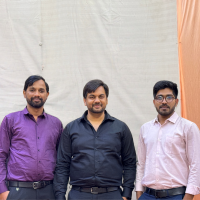In today’s hyper-connected world, cybersecurity is more crucial than ever. As technology races forward, so do the dangers we face. From cunning phishing scams to ransomware and beyond, the cybersecurity landscape is in a state of constant flux. To stay ahead of the curve, it’s vital to grasp the newest trends and tools in cybersecurity. In this blog, brought to you by NewRise Technosys, we’ll dissect some of the most important developments shaping the future of online security.
1. Artificial Intelligence and Machine Learning: The Dynamic Duo of Cybersecurity
Artificial intelligence (AI) and machine learning (ML) are transforming cybersecurity. These technologies can analyze massive amounts of data at lightning speed, identifying patterns and anomalies that might signal potential threats.
Here’s how AI and ML can supercharge your cybersecurity:
• Threat Detection: AI systems can uncover unusual activity that could hint at a breach, often outpacing human analysts.
• Automated Responses: ML algorithms can automatically counter specific kinds of attacks, minimizing the time it takes to address threats.
• Threat Prediction: By analyzing past data, AI can predict future threats, allowing organizations to bolster their defenses beforehand.
2. Zero Trust Architecture: A New Approach to Network Security
The traditional method of perimeter defense is becoming obsolete. Zero Trust Architecture (ZTA) is built on the principle of “never trust, always verify.” It assumes that threats can originate from both inside and outside the network.
Key features of Zero Trust:
• Least Privilege Access: Users are granted only the minimal access required to perform their tasks.
• Micro-Segmentation: Networks are divided into smaller, isolated segments to limit the spread of an attack.
• Continuous Monitoring: User identity and device health are constantly verified throughout the network.
3. Ransomware as a Service: A Growing Menace
Ransomware attacks are on the rise, fueled by Ransomware-as-a-Service (RaaS). This model empowers even those with minimal technical expertise to launch ransomware attacks by purchasing pre-made ransomware kits on the dark web.
How to combat Ransomware:
• Regular Backups: Maintain up-to-date backups of all critical data to restore systems in case of an attack.
• Employee Training: Educate employees about phishing scams and other tactics commonly used to deploy ransomware.
• Advanced Endpoint Protection: Utilize robust endpoint protection solutions to detect and block ransomware before it can strike.
4. Cloud Security: Protecting Your Data in the Cloud
As more organizations shift to the cloud, securing cloud-based assets has become a top priority. Cloud security solutions are evolving to address the unique challenges of this environment.
Trends in Cloud Security:
• Shared Responsibility: Understand the division of security responsibilities between the cloud provider and the customer.
• Cloud Security Tools: Utilize tools like Cloud Access Security Brokers (CASBs) to enforce security policies across cloud services.
• Secure Access Service Edge (SASE): This combines networking and security functions in the cloud to guarantee secure access to applications.
5. Basic Cyber Hygiene: The Foundation of a Secure System
Good cyber hygiene practices are the bedrock of any security strategy. These include regular software updates, strong password policies, and multi-factor authentication (MFA).
Essential Cyber Hygiene Practices:
• Patch Management: Regularly update and patch software to shield yourself from known vulnerabilities.
• Password Management: Implement strong, unique password policies and consider using password managers.
• Multi-Factor Authentication: Add an extra layer of security by requiring more than just a password for access.
The Bottom Line
Cybersecurity is constantly evolving, driven by rapid technological advancements and the ever-changing tactics of cybercriminals. Staying informed about the latest trends and technologies empowers organizations to defend themselves against the myriad threats in the digital landscape. By adopting AI and machine learning, embracing Zero Trust principles, preparing for the rise of ransomware, securing cloud environments, and maintaining good cyber hygiene, organizations can build a robust cybersecurity strategy.
At NewRise Technosys, we believe that staying secure requires vigilance, education, and adaptability. The digital world may be fraught with challenges, but with the right knowledge and tools, we can navigate it safely and confidently. Stay tuned for more insights and updates on cybersecurity, and together, let’s build a more secure digital future.
FAQs
What is cybersecurity?
Cybersecurity is the practice of protecting systems, networks, and data from unauthorized access, use, disclosure, disruption, modification, or destruction.
Why is cybersecurity important?
Cybersecurity is crucial in today’s digital age because our personal and professional lives rely heavily on technology. Cyberattacks can steal sensitive data, disrupt operations, and cause financial loss.
What is artificial intelligence (AI) and how does it help with cybersecurity?
AI can analyze vast amounts of data to identify patterns and anomalies that might indicate a potential cyberattack. It can also automate responses to certain threats, reducing the time it takes to address them.
What is machine learning (ML) and how does it benefit cybersecurity?
ML algorithms can learn and improve over time, becoming better at detecting and responding to cyber threats. They can also be used to predict future attacks based on historical data.
What is Zero Trust Architecture (ZTA) and how does it improve security?
ZTA assumes that no user or device should be inherently trusted. Every access attempt must be verified before granting access to sensitive data or systems. This approach minimizes the damage caused by a security breach.
What is Ransomware-as-a-Service (RaaS) and how can I protect myself?
RaaS makes it easier for anyone to launch a ransomware attack by providing pre-made ransomware kits. To protect yourself, keep regular backups of your data, educate employees on cybersecurity awareness, and use endpoint protection software.
What are some key considerations for cloud security?
Cloud security involves understanding the shared responsibility between the cloud provider and the customer for securing data and applications. Utilize cloud security tools like CASBs and implement Secure Access Service Edge (SASE) for secure access to cloud applications.
What are some essential cyber hygiene practices?
Essential cyber hygiene practices include keeping software up to date, using strong and unique passwords, enabling multi-factor authentication (MFA), and being cautious about clicking on suspicious links or attachments.
How can I stay informed about the latest cybersecurity threats?
Follow reputable cybersecurity blogs and news sources, attend industry events, and participate in cybersecurity training programs.





